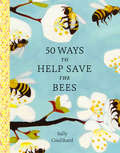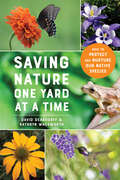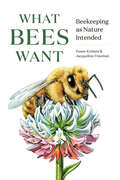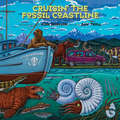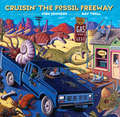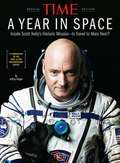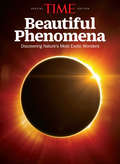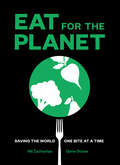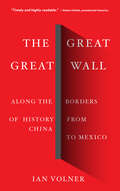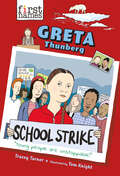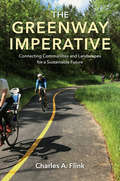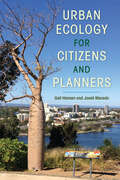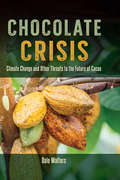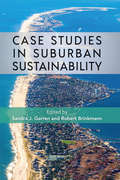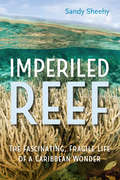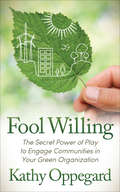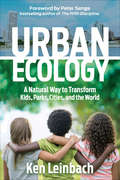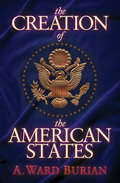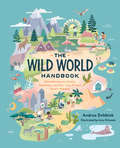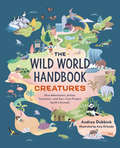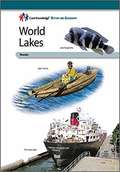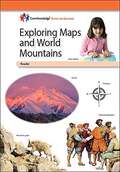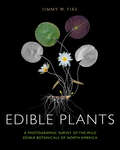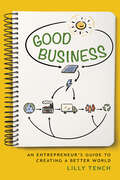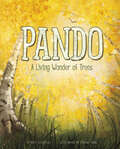- Table View
- List View
50 Ways to Help Save the Bees
by Sally CoulthardHave you heard the buzz? Bees—the tiny insects that pollinate nearly all our fruits and vegetables—need our support. If you like to eat your fruits and vegetables (and even if you don’t!), you should value our planet’s bees. Yet, because of environmental pollution, loss of green spaces, and a general disregard for the well-being of insects, humans have caused the number of bees to plummet. In the past year, the managed honeybee population of the United States has dropped 40 percent, and there has been a 25 percent decline in wild bees—figures that are alarming at best. Helping the bees is easier than you might imagine, however, as outlined in this charmingly illustrated call to action. Here are 50 easy suggestions, along with an informative introduction, to get you started. Try cutting your lawn less frequently, buying ethical honey, and keeping your yard dark at night. You can follow easy instructions for building a bee-friendly window box or a green-roofed garden shed. Little things can make a big difference. Just ask a bee.
Saving Nature One Yard at a Time: How to Protect and Nurture Our Native Species
by David Deardorff Kathryn WadsworthDiscover 100 ways to support endangered plant and wildlife species in your community and beyond. David Deardorff and Kathryn Wadsworth present 100 home projects designed to inspire and empower anyone who wants to help save our native flora and fauna in the face of habitat loss and climate change. This book focuses on saving creatures and plants that are especially vulnerable but that can be successfully helped by our efforts, such as bees, frogs, butterflies, birds, trees, and wildflowers. Each project meets four crucial criteria: (1) it will make a significant difference to the survival of the species, (2) has a high likelihood of success, (3) is easy to implement, and (4) is family-friendly. The book raises awareness of endangered species that readers can help by undertaking projects unique to their bioregion. Examples include building an amphibian house for salamanders, raising tadpoles, creating nesting sites for bees, and much more. Saving Nature One Yard at a Time is an inspirational and practical compendium that will give readers the knowledge and tools they need to take an active role in nurturing the world around us, no matter we live.
What Bees Want: Beekeeping as Nature Intended
by Susan Knilans Jacqueline FreemanBee populations are plummeting. The solution? Give them what they need to live naturally, and they’ll handle the rest. Susan Knilans and Jacqueline Freeman are in love with bees. So in love that they observe their bees—their work, communication, seasonal activity, and more—for hours each day. And with observation came realization: when bees are allowed to live as they would in nature (with smaller hives, no chemicals, freedom to swarm, and little-to-no human interference), they will thrive. Accordingly, Knilans and Freeman have spent decades perfecting the revolutionary practice of preservation beekeeping, guided by the simple question, “What do the bees want?” A surprising page-turner, this instructional book tells the story of their successes and failures, demonstrating what was learned along the way. Sharing preservation beekeeping’s key tenets, the authors provide concrete, simple ways to implement their approach, from finding the right hive location to honing observation skills. This preservation manifesto is a vital addition to any beekeeper’s library, imparting all the joys of a beekeeper's life.
Cruisin' the Fossil Coastline: The Travels of an Artist and a Scientist along the Shores of the Prehistoric Pacific
by Kirk R. Johnson Ray TrollIn this long-awaited sequel Kirk Johnson and Ray Troll are back on a road trip—driving, flying, and boating their way from Baja, California to northern Alaska in search of the fossil secrets of North America's Pacific coast. They hunt for fossils, visit museums, meet scientists and paleonerds, and sleuth out untold stories of extinct worlds. As one of the oldest coasts on earth, the west coast is a rich ground for fossil discovery. Its wonders include extinct marine mammals, pygmy mammoths, oyster bears, immense ammonites, shark-bitten camels, polar dinosaurs, Alaskan palms, California walruses, and a lava-baked rhinoceros. Join in for a fossil journey through deep time and discover how the west coast became the place it is today.
Crusin' the Fossil Freeway: An Epoch Tale of a Scientist and an Artist on the Ultimate 5,000-Mile Paleo Road Trip
by Kirk JohnsonThe travels of a paleontologist and an artist as they drive across the American West in search of fossils. Throughout their journey, they encounter "paleonerds" like themselves, people dedicated to finding everything from suburban T. rexes to ancient fossilized forests.
TIME A Year in Space: Inside Scott Kellys Historic Mission Is Travel to Mars Next?
by The Editors of TIME Jeffrey KlugerGo inside one of the most historic space missions ever in A YEAR IN SPACE, the new special edition from TIME, written by Apollo 13 author Jeffrey Kluger. A YEAR IN SPACE chronicles astronaut Scott Kelly's 340 days aboard the International Space Station (ISS) as part of NASA's exploration of the challenges of extended spaceflight. The most pressing question: Could humans endure the two-and-a-half-year trip to Mars and back?While science has some understanding of how space and zero gravity affect the human body, Scott and his twin brother, Mark, a retired astronaut who remained on Earth, have served as the perfect test and control subjects to explore these effects.This special edition, the companion piece to the TIME and PBS documentary series A Year in Space, provides exclusive coverage coupled with abundant photographs, many taken by Scott Kelly himself.Highlights include:An inside look at how Kelly conducted experiments aboard the ISS and how he spent his downtime.Landscape Mode: Breathtaking photographs taken by Scott Kelly from 250 miles above the Earth's surface.In interview with Samantha Cristoforetti, the first woman to spend 200 days in space, who spoke with TIME about her journey.
TIME Beautiful Phenomena: Discovering Nature's Most Exotic Wonders
by The Editors of TIME MagazineYour guide to the science of eclipses, rainbows, volcanoes, and nature's many wonders.Powerful and dramatic, the natural wonders of our earth dazzled our ancient ancestors-and continue to inspire awe in us today. Now, the Editors of TIME capture these amazing sights and occurrences in an all-new special edition, Beautiful Phenomena, pairing glowing photographs with clear, authoritative text that explains the how, what, why, and when of nature's wonders, including eclipses, rainbows, lightning, supermoons, auroras and so much more. Learn about the scientific breakthroughs that came from observing solar eclipses and other natural phenomena over the centuries . . . and discover the latest theories about them that are emerging today. In space, in the oceans, on the land, these natural wonders hold the keys to our understanding of the world around us. Unlock their mysteries with TIME Beautiful Phenomena.
Eat for the Planet: Saving the World One Bite at a Time
by Nil Zacharias Gene Stone“An indispensable guide for anyone who wants to live to age 100—by making sure there’s a livable world when you get there.” —Dan Buettner, New York Times–bestselling author of The Blue ZonesDo you consider yourself an environmental ally? Maybe you recycle your household goods, ride a bike, and avoid too much air travel. But did you know that the primary driver of climate change isn’t plastics, or cars, or airplanes? Did you know that it’s actually our industrialized food system? In this fascinating new book, authors Nil Zacharias and Gene Stone share new research, intriguing infographics, and compelling arguments that support what scientists across the world are beginning to affirm and uphold: By making even minimal dietary changes, anyone can have a positive, lasting impact on our planet. If you love the planet, the only way to save it is by switching out meat for plant-based meals, one bite at a time.“This fascinating, easy-to-read book will give you still another reason to eat plants and not animals: you will be doing a world of good—literally!” —Rip Esselstyn, #1 New York Times–bestselling author of Plant-Strong“Eating plants is not just good for your own health, it’s imperative for the health of the planet. This well-argued, well-written book makes it clear why everyone should consider a plant-based diet today.” —Michael Greger, MD, New York Times–bestselling author of How Not to Die“Possibly the single most important environmental book I’ve read in years. A must for everyone.” —Kathy Freston, New York Times–bestselling author of The Lean
The Great Great Wall: Along the Borders of History from China to Mexico
by Ian Volner“Timely and highly readable . . . provides a valuable backdrop to Donald Trump’s insistence on a barrier across America’s southern border.” —Robert Dallek, presidential historianDuring his campaign for the presidency, one of Donald Trump’s signature promises was that he would build a “great great wall” on the border between the US and Mexico, and Mexico was going to pay for it. Now, with only a few prototype segments erected, the wall is the 2,000-mile, multibillion-dollar elephant in the room of contemporary American life.In The Great Great Wall, architectural historian and critic Ian Volner takes a fascinating look at the barriers that we have built over millennia. Traveling far afield, to China, the Middle East, Europe, and along the U.S. Mexico border, Volner examines famous, contentious, and illuminating structures, and explores key questions: Why do we build walls? What do they reveal about human history? What happens after they go up? With special attention to Trump’s wall and the walls that exist along the US border already, this is an absorbing, smart, and timely book on an incredibly contentious and newsworthy topic.“A work of literary alchemy that transmutes the wall, a simple architectural structure, and of late, political metaphor, into a prism through which to view the panorama of human history . . . this book will amaze, delight, and enchant even the most jaded nonfiction aficionado.” —William J. Bernstein, award-winning author of The Delusions of Crowds“A global journey to some of history’s most significant walls—China, Berlin, and even Jericho—weaving together a fascinating account of their foundational myths and current realities.” —Carrie Gibson, author of El Norte
Greta Thunberg (First Names)
by Tracey TurnerIn author Tracey Turner and illustrator Tom Knight’s Greta Thunberg, a biography in the First Names series, meet the young Swedish activist who is standing up to climate change! Before she was a well-known environmentalist activist, Greta Thunberg was just a girl living in Stockholm, Sweden. She first heard about climate change when she was only eight years old, and she couldn’t understand why no one seemed to be doing anything about it. When she was 15 years old, she began spending her days outside the Swedish Parliament to call for action on climate change. She’d sit outside the whole school day with a sign that read “School strike for climate.” Soon, other students began to follow Greta’s lead and participate in similar protests, and together, these kids organized the Fridays for Future climate strike movement. Greta also is an inspiration to many because she has Asperger’s Syndrome and is very open in talking about her diagnosis, further destigmatizing it. Today, Greta continues to fight for climate change—and continues to prove that you’re never too young to make a difference! First Names is a highly illustrated nonfiction series that puts readers on a first-name basis with some of the most incredible people in history and of today! The First Names series:Harry HoudiniAmelia EarhartAda LovelaceMalala YousafzaiFerdinand MagellanBeyoncé Nelson MandelaGreta Thunberg
The Greenway Imperative: Connecting Communities and Landscapes for a Sustainable Future
by Charles A. FlinkTrailblazing greenway projects from vision to reality In this eye-opening journey through some of America’s most innovative landscape architecture projects, Charles Flink shows why we urgently need greenways. A leading authority in greenway planning, design, and development, Flink presents inspiring examples of communities that have come together to build permanent spaces for the life-sustaining power of nature. The Greenway Imperative reveals the stories behind a variety of multiuse natural corridors, taking readers to Grand Canyon National Park, suburban North Carolina, the banks of the Miami River, and many other settings. Flink, who was closely involved with each of the projects in this book during his 35-year career, introduces the people who jumpstarted these initiatives and the challenges they overcame in achieving them. Flink explains why open green spaces are increasingly critical today. “Much more than a path through the woods,” he says, greenways conserve irreplaceable real estate for the environment, serve as essential green infrastructure, shape the way people travel within their communities, reduce impact from flooding and other natural disasters, and boost the economies of cities and towns. Greenways can and should dramatically reshape the landscape of America in the coming years, Flink argues. He provides valuable reflections and guidance on how we can create resilient communities and satisfy the human need for connection with the natural world.
Urban Ecology for Citizens and Planners
by Gail Hansen Joseli MacedoIdeal for city residents, developers, designers, and officials looking for ways to bring urban environments into harmony with the natural world and make cities more sustainable, Urban Ecology for Citizens and Planners offers a wealth of information and examples that will answer fundamental scientific questions, guide green initiatives, and inform environmental policies and decision-making processes. This book provides an overview of the synergistic relationships between humans and nature that shape the ecology of urban green spaces. It also emphasizes the social and cultural value of nature in cities for human health and well-being. Chapters describe the basic science of natural components and ecosystems in urban areas and explore the idea of biophilic urbanism, the philosophy of building nature into the framework of cities. To illustrate these topics, chapters include projects, case studies, expert insights, and successful citizen science programs from urban areas around the world. Authors Gail Hansen and Joseli Macedo argue that citizens have increasingly important roles to play in the environmental future of the cities they live in. A valuable resource for real-world solutions, this volume encourages citizens and planners to actively engage and collaborate in improving their communities and quality of life.
Chocolate Crisis: Climate Change and Other Threats to the Future of Cacao
by Dale WaltersChocolate is the center of a massive global industry worth billions of dollars annually, yet its future in our modern world is currently under threat. In Chocolate Crisis, Dale Walters discusses the problems posed by plant diseases, pests, and climate change, looking at what these mean for the survival of the cacao tree.Walters takes readers to the origins of the cacao tree in the Amazon basin of South America, describing how ancient cultures used the beans produced by the plant, and follows the rise of chocolate as an international commodity over many centuries. He explains that most cacao is now grown on small family farms in Latin America, West Africa, and Indonesia, and that the crop is not easy to make a living from. Diseases such as frosty pod rot, witches’ broom, and swollen shoot, along with pests such as sap-sucking capsids, cocoa pod borers, and termites, cause substantial losses every year. Most alarmingly, cacao growers are beginning to experience the accelerating effects of global warming and deforestation. Projections suggest that cultivation in many of the world’s traditional cacao-growing regions might soon become impossible.Providing an up-to-date picture of the state of the cacao bean today, this book also includes a look at complex issues such as farmer poverty and child labor, and examines options for sustainable production amid a changing climate. Walters shows that the industry must tackle these problems in order to save this global cultural staple and to protect the people who make their livelihoods from producing it.
Case Studies in Suburban Sustainability
by Sandra J. Garren and Robert BrinkmannThe first volume to focus on suburbs and sustainability in the United States, this collection approaches the topic through regionally diverse case studies. Departing from the more widely examined issue of urban sustainability, contributors argue that the suburbs present a unique and important challenge given their greater land mass, lower population density, lower tax rates, and more limited government services. The studies featured in this volume analyze the impact of planning, social and economic concerns, environmental factors such as air pollution and climate change, and water management on suburban communities. Areas of focus include suburbs of New York City, Seattle, Pittsburgh, Los Angeles, Phoenix, New Orleans, and Tampa. In these examples, contributors show that activism and leadership are currently advancing a strong sustainability agenda in regions many would have believed unlikely. Through these case studies, this volume demonstrates that the suburbs are a crucial nexus for sustainability in the United States. Because suburbs have been overlooked in most green initiatives, and because they play such a vital role in the future of American housing and development, these essays call for more research and continued creative innovation in these areas. Contributors: Troy D. Abel | Simon A. Andrew | Viney P. Aneja | Miles Ballogg | William H. Battye | Casey D. Bray | Vaswati Chatterjee | Stacy Clauson | Craig E. Colten | Sarah Combs | Yonn Dierwechter | Richard C. Feiock | Michael H. Finewood | Melissa M. Grigione | John Harner | Mathew K. Huxel | Mike Johnson | Gabrielle R. Lehigh | Elizabeth Mattiuzzi | Sean McGreevey | Susan M. Opp | Michaela C. Peterson | Benjamin L. Ruddell | Richard R. Rushforth | Debra Salazar | Ronald Sarno | Mallory Thomas | Carolina A. Urrea | Pornpan Uttamang | E. Christian Wells
Imperiled Reef: The Fascinating, Fragile Life of a Caribbean Wonder
by Sandy SheehyThe beauty and drama of a world beneath the surface of the waves This book brings alive the richly diverse world of an underwater paradise: the Mesoamerican Barrier Reef. Stretching 625 miles through the Caribbean Sea along the coasts of Mexico, Belize, Guatemala, and Honduras, this reef is the second largest coral structure on the planet. Imperiled Reef searches out the breathtaking intricacies of this endangered ecological treasure. Research shows that the future of the reef is at risk, Sheehy explains. Looking closely at threats ranging from global warming to overfishing to irresponsible development, Sheehy draws attention to the inspiring efforts of nongovernmental agencies, scientists, and local communities who are working together to address these challenges. She includes practical actions individuals can take to protect this reef—as well as marine ecosystems everywhere. Celebrating a vast, submerged landscape that has too often been undervalued, Imperiled Reef is both a strong case for protecting an international marvel and a powerful message of hope for the world’s oceans.
Fool Willing: The Secret Power of Play to Engage Communities in Your Green Organization
by Kathy OppegardImagine what having more advocates could do for environmental organization: more engaged volunteers, more political wins for conservation, more financial support, and more enthusiastic collaborations. The U.S. is fortunate to have people from many different cultures and ethnicities, yet so many of these good folks have not been invited to full participation in the green movement.Fool Willing is a playful, practical guide for welcoming and including all communities at the “green table.” Putting a happy little kid, a salsa-dancing event planner, and Jane Goodall in the same room, Fool Willing would be what they would write together. Its light-hearted voice invites readers to bring playfulness and practicality as they make advances for people and the planet. Author and certified Martha Beck Life Coach, Kathy Oppegard helps people in environmental organizations bring communities into full participation in their organizations and volunteer teams. She has coordinated hundreds of volunteers for multiple events. Dig in and get ready to have more fun and be more effective as you grow your community in your green organization today!
Urban Ecology: A Natural Way to Transform Kids, Parks, Cities, and the World
by Ken LeinbachWith climate change in the news, an urban core that has reached boiling point, and many children growing up without role models and with limited dreams, where is hope? There is a quiet experiment in Milwaukee that is turning heads. It starts with the simplicity of getting a city kid exploring their neighborhood park. How is it that so much life, community, and opportunity can grow from this unlikely soil? It's been called a miracle. It's contagious. It's spreading. It's exciting. And it works! This is the story of a group of ordinary people in a neighborhood who created something extraordinary. Readers will discover… the power of getting a city kid outside in nature; that kindness does work; how to say no while following the yes; the value of clarity and focus; how to find abundance within their own diverse community by simply and humbly asking for help; ten tried and tested rules for raising money (a lot of it!) while having a ton of fun doing it; a positive, believable, and very real vision for the future of the environment (we've got this!); and... how to join the Urban Ecology movement.
The Creation of the American States
by A. Ward BurianThe fascinating story of how and why all fifty American states were formed—and how they became a part of history’s greatest social experiment. Every US state has a unique history that deserves a separate book. The Creation of the AmericanStates provides readers with essential information on how each of the fifty states came into being. From the time of the first explorers and settlers to the present day, A. Ward Burian tells the story of how the America was established over the course of four hundred years. He examines what motivated brave souls to venture into an unknown wilderness and then delves into the time frame for each state’s discovery, settlement, and consolidation into the United States. With brief biographies interjected that spark human interest and provide perspective to what was taking place, The Creation of the American States shares a better understanding of how the North American continent was transformed from a wilderness into a powerful nation—state by state.
The Wild World Handbook: Habitats (The Wild World Handbook #1)
by Andrea DebbinkPacked with real-life tales of adventure, breathtaking illustrations, and practical tips, this handbook is an inspiring guide for the next generation of climate activists, conservationists, and nature lovers.The wonder of the natural world surrounds us—from the Amazon rainforest to the snowy peaks of Mount Everest to the green spaces in big cities. And as the threat of climate change grows, it&’s more important than ever to show appreciation for our planet by taking action.The first book in a middle grade series for young environmental activists and nature lovers, The Wild World Handbook offers a roadmap for change and an invitation to explore the outdoors, alongside surprising facts and hands-on STEAM activities. Featuring nine habitats from around the globe, each section includes diverse biographies of outdoor adventurers, scientists, and artists who used their passion and skills to become bold allies for Earth&’s natural diversity and resiliency.Inside you will find: • Nine Amazing Habitats • Eighteen Inspiring Biographies • Nine Kid-Friendly DIY Activities • Nine Fun Field Trips • And much more! It&’s up to us to protect this beautiful, awe-inspiring planet we call home!
The Wild World Handbook: Creatures (The Wild World Handbook #2)
by Andrea DebbinkPacked with real-life tales of adventure, breathtaking illustrations, and practical tools, this handbook is an inspiring guide for the next generation of climate activists, conservationists, and nature lovers.We share this incredible planet we call home with countless living creatures, from butterflies and falcons to koalas and dolphins. And just like us, animals everywhere are faced with the growing threat of climate change. Featuring seven categories of creatures, this handbook offers a roadmap for change and an invitation to explore the outdoors with fascinating facts, hope-filled stories, and hands-on STEAM activities. Each chapter highlights the biographies of scientists, artists, and adventurers from diverse backgrounds who have used their passion and skills to become courageous advocates for animals around the world. The second book in a middle-grade series for young activists and conservationists, The Wild World Handbook: Creatures empowers readers to appreciate and protect Earth&’s wildlife.Inside you will find: • Seven incredible categories of creatures • Fourteen inspiring biographies • Seven kid-friendly DIY activities • Seven fun field trips • And much more!
World Lakes (Core Knowledge History and Geography)
by Core Knowledge FoundationWORLD LAKES begins with a review of map skills and geographical terms. Students learn about the benefits and resources provided by lakes, including, in Asia, the Caspian and Aral Seas; in Africa, Lakes Victoria, Tanganyika, and Chad; in South America, Lakes Maracaibo and Titicaca; and, in North America, Lakes Superior, Huron, Michigan, Erie, and Ontario.
CKHG - Core Knowledge History and Geography Exploring Maps and World Mountains
by Core Knowledge FoundationFrom the CORE KNOWLEDGE FOUNDATION, which brought you the popular “What Your ___ Grader Needs to Know” series. EXPLORING MAPS AND WORLD MOUNTAINS is divided into two parts. The first part explains geographical terms and concepts to help students use maps and globes effectively, including map symbols, keys, scales, and longitude and latitude. The second part reinforces map skills while introducing major mountains and mountain ranges. Paperback. 100 pages. ** Part of the CORE KNOWLEDGE HISTORY AND GEOGRAPHY (CKHG) series in world and American history and geography, integrating topics in civics and the arts. CKHG books offer engagingly written text with many color illustrations, maps, vocabulary sidebars, and a glossary. Related materials (Teacher Guides and Timeline Cards) are also published by the Core Knowledge Foundation. In general, CKHG books are appropriate for young readers from the upper elementary grades through middle school.
Edible Plants: A Photographic Survey of the Wild Edible Botanicals of North America
by Jimmy FikeFor over a decade, artist Jimmy Fike traveled across the continental United States in an epic effort to photograph wild edible flora. Edible Plants is the culmination of that journey, featuring over 100 photographs that Fike has selectively colorized to highlight the comestible part of the plant. While the images initially appear to be scientific illustrations or photograms from the dawn of photography when plants were placed directly on sensitized paper and exposed under the sun, a closer look reveals, according to Liesl Bradner of the Los Angeles Times, "haunting [and] eerily beautiful" photographs. Beyond instilling wonder, Fike's contemporary, place-based approach to landscape photography emphasizes our relationship to the natural world, reveals food sources, and encourages environmental stewardship. His clever and beautiful method makes it easy to identify both the specimen and its edible parts and includes detailed descriptions about the plant's wider purposes as food and medicine.Sumptuously illustrated and delightfully informative, Edible Plants is the perfect gift for anyone curious about unlocking the secrets of native North American plants.
Good Business: An Entrepreneur's Guide to Creating a Better World
by Lilly TenchGood Business: An Entrepreneur's Guide to Creating a Better World is an illustrated guide that takes readers through the complicated but exhilarating landscape of social enterprise businesses that are changing the world.A social enterprise is a different kind of business, one that uses a market-driven approach to address a social or environmental problem such as poverty, environmental damage, or resource scarcity, with the dual goals of helping humanity and building a profitable business.With a climate crisis, a growing population, and diminishing natural resources, the need for socially-minded innovators is greater than ever. Good Business is designed to be a practical guide and tool for innovators, entrepreneurs, and dreamers who are attempting to navigate the complicated business models required for social enterprises.
Pando: A Living Wonder of Trees
by Author Kate Allen FoxPando is an inspiring tribute to a Utah grove of quaking Aspen trees connected by their roots to form one of the world's oldest and largest living things. Author Kate Allen Fox engages readers’ senses to help convey the vastness of Pando, the challenges it faces, and how we all can be part of the solution. With lyrical poetry, Fox summarizes the science, action, and compassion needed to save this wonder of nature.
